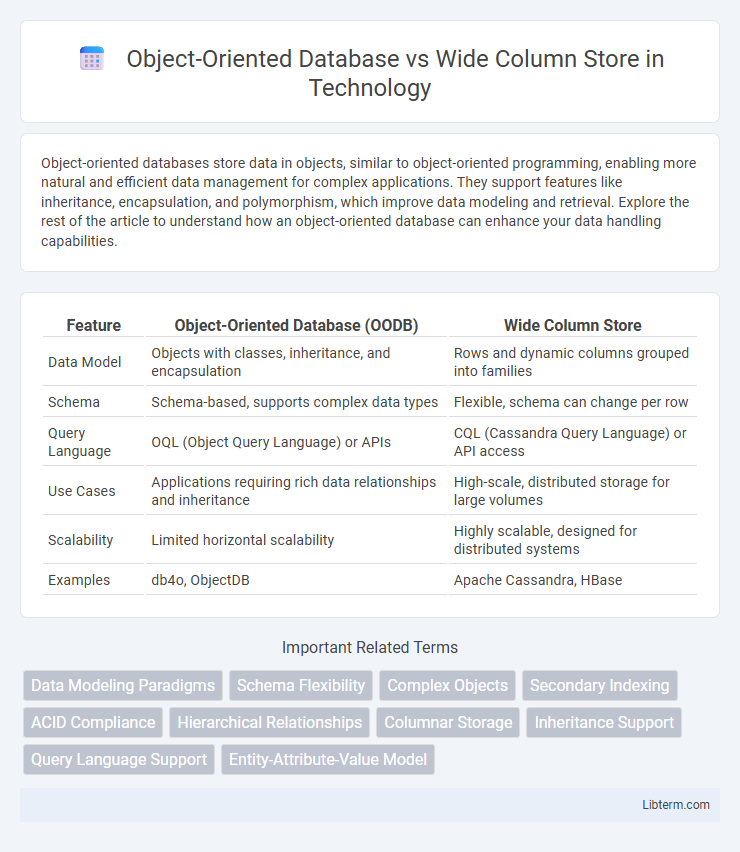Object-oriented databases store data in objects, similar to object-oriented programming, enabling more natural and efficient data management for complex applications. They support features like inheritance, encapsulation, and polymorphism, which improve data modeling and retrieval. Explore the rest of the article to understand how an object-oriented database can enhance your data handling capabilities.
Table of Comparison
| Feature | Object-Oriented Database (OODB) | Wide Column Store |
|---|---|---|
| Data Model | Objects with classes, inheritance, and encapsulation | Rows and dynamic columns grouped into families |
| Schema | Schema-based, supports complex data types | Flexible, schema can change per row |
| Query Language | OQL (Object Query Language) or APIs | CQL (Cassandra Query Language) or API access |
| Use Cases | Applications requiring rich data relationships and inheritance | High-scale, distributed storage for large volumes |
| Scalability | Limited horizontal scalability | Highly scalable, designed for distributed systems |
| Examples | db4o, ObjectDB | Apache Cassandra, HBase |
Introduction to Object-Oriented Databases and Wide Column Stores
Object-oriented databases store data as objects, integrating database capabilities with object-oriented programming to represent complex data and relationships natively. Wide column stores organize data into flexible, column-oriented tables optimized for large-scale distributed storage and fast read/write operations, often used in Big Data and real-time analytics. Both models address different data management needs, with object-oriented databases emphasizing rich data structures and wide column stores focusing on scalability and performance in handling massive datasets.
Core Concepts: Objects vs Column Families
Object-oriented databases organize data using objects, encapsulating both state and behavior, enabling complex data modeling with inheritance and polymorphism. Wide column stores structure data into column families, optimizing for high scalability and efficient querying of sparse datasets with flexible schema design. Objects emphasize encapsulated data and relationships, while column families prioritize scalable storage and retrieval across distributed systems.
Data Modeling Differences
Object-oriented databases organize data as objects, encapsulating both state and behavior, which suits complex, interrelated data and supports inheritance and polymorphism. Wide column stores model data in flexible, schema-less tables with rows and dynamic columns grouped into column families, optimizing for high scalability and sparse data storage. The key difference lies in object-oriented databases emphasizing rich data relationships and behavior, whereas wide column stores prioritize efficient, distributed storage of large volumes of semi-structured data.
Schema Flexibility and Evolution
Object-oriented databases offer schema flexibility by allowing complex data types and inheritance hierarchies, enabling seamless evolution of object models without extensive schema redesign. Wide column stores provide dynamic column families and sparse rows, supporting schema evolution through easy addition or removal of columns without impacting existing data. Both database types cater to evolving application requirements but differ in approach: object-oriented databases emphasize rich data modeling, while wide column stores prioritize scalable, flexible schema adjustments in distributed environments.
Query Capabilities and Language Support
Object-oriented databases provide rich query capabilities through object query languages such as OQL, enabling complex queries on deeply nested objects with inheritance and polymorphism support. Wide column stores use query languages like CQL (Cassandra Query Language) for efficient retrieval of large volumes of denormalized, tabular data across distributed nodes, optimized for fast key-value lookups and range queries. Object-oriented databases excel in handling complex relationships and behavioral data, whereas wide column stores prioritize scalability and high-throughput queries on sparse datasets.
Performance and Scalability Comparison
Object-oriented databases excel in complex data modeling and support for inheritance, enabling efficient handling of interconnected objects but may face challenges with horizontal scalability. Wide column stores, designed for distributed architectures, offer high write throughput and seamless horizontal scaling by partitioning data across multiple nodes, making them ideal for large-scale, high-velocity workloads. Performance in object-oriented databases may degrade with increased data volume due to complex joins, whereas wide column stores maintain consistent low-latency responses under heavy load by optimizing data locality and parallel processing.
Transaction Management and Consistency
Object-oriented databases excel in transaction management by supporting complex data types and ensuring strong ACID compliance, which guarantees high consistency and atomicity across object manipulations. Wide column stores, such as Apache Cassandra and HBase, prioritize scalability and availability, often adopting eventual consistency models with tunable consistency levels to handle distributed transactions across massive datasets. Transaction management in wide column stores typically relies on lightweight transactions or batch processing, sacrificing strict consistency for performance and horizontal scalability.
Use Case Suitability and Industry Adoption
Object-oriented databases excel in complex applications requiring tight integration of object-oriented programming and persistent storage, making them suitable for domains like computer-aided design, multimedia, and engineering simulations. Wide column stores offer high scalability and flexibility for handling large volumes of sparse data, making them ideal for big data analytics, real-time web applications, and IoT platforms. Industry adoption favors wide column stores such as Apache Cassandra and HBase in telecom, finance, and social media, whereas object-oriented databases remain more niche, primarily used in specialized software development and scientific research.
Integration, Ecosystem, and Tooling
Object-oriented databases natively support complex data types and relationships, making integration with object-oriented programming languages seamless and enhancing developer productivity. Wide column stores excel in horizontal scalability and are optimized for handling large volumes of sparse data, with robust ecosystems centered around big data frameworks like Apache Cassandra and HBase. Tooling for object-oriented databases often includes ORMs and integrated development environments tailored for complex data models, while wide column stores benefit from mature monitoring, replication, and distributed query tools suited for cloud-native and scalable applications.
Summary Table: Key Differences and Decision Factors
Object-oriented databases excel in managing complex data with rich relationships using encapsulation, inheritance, and polymorphism, making them ideal for applications requiring sophisticated data modeling. Wide column stores offer high scalability and flexibility for handling massive volumes of distributed, sparse, and semi-structured data with fast read/write operations, suited for big data and real-time analytics. Key decision factors include the complexity of data structures, scalability needs, query patterns, and consistency requirements, with object-oriented databases favoring intricate, relationship-heavy models while wide column stores prioritize horizontal scaling and schema flexibility.
Object-Oriented Database Infographic

 libterm.com
libterm.com